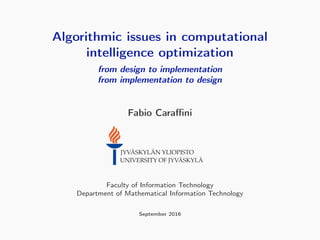This document provides an overview of algorithmic issues in computational intelligence optimization from design to implementation. It discusses key concepts in optimization problems including analytical approaches, exact methods, approximate iterative methods, and metaheuristics. It also examines challenges in optimizing real-world problems that are highly non-linear, multi-modal, computationally expensive, and have memory/time constraints. The document concludes by discussing the need for algorithms to balance exploration and exploitation and to adapt to problem landscapes.











![Lectio Precursoria References
Hard real-life:
MEMORY/TIME CONSTRAINTS
These scenarios have to be carefully addressed by designing
algorithm tailored to the specific case:
the design is implementation-driven!
(from implementation to design)
implementation limitations have to be considered first to be
able to carry out the optimization process in such constraints.
Chapter 3 of my thesis addresses mamory-saving and
real-time optimization:
PI: “compact differential evolution light”
[Iacca et al., 2012a]
PII: “space robot base disturbance optimization”
[Iacca et al., 2012b]
PIII: “MC for path-following mobile robots”
[Iacca et al., 2013]
PIV: “µ-DE with extra moves along the axes”
[Caraffini et al., 2013c]
Fabio Caraffini University of Jyväskylä](https://image.slidesharecdn.com/22a25686-2261-4567-b531-181bdc3ad584-160921151437/85/DEFENSE-12-320.jpg)

![Lectio Precursoria References
Historical successful strategies
Fogel Owens (USA, 1964): Evolutionary Programming (EP)
[Fogel et al., 1964], see also [Fogel et al., 1966]
Holland (USA, 1975): Genetic Algorithm (GA)
[Holland, 1975]
Rechenberg Schwefel (Germany, 1971): Evolution Strategies (ES)
[Rechenberg, 1971]
Koza (USA, 1990): Genetic Programming (GP)
[Koza, 1990], see also [Koza, 1992b] and [Koza, 1992a]
Moscato (Argentina-USA 1989): Memetic Algorithms (MA)
[Moscato, 1989]
Storne and Price (Germany-USA 1995): Differential Evolution (DE)
[Storn and Price, 1995]
Eberhart (USA 1995): Particol Swarm Optimization
[Eberhart and Kennedy, 1995]
Fabio Caraffini University of Jyväskylä](https://image.slidesharecdn.com/22a25686-2261-4567-b531-181bdc3ad584-160921151437/85/DEFENSE-14-320.jpg)
![Lectio Precursoria References
What is the best strategy?
There is no best optimiser! [Wolpert and Macready, 1997]
The 1st of the No Free Lunch Theorems (NFLT) presented in
[Wolpert and Macready, 1997] states that for a given pair of
algorithms A and B:
f
P(xm m, f , A) =
f
P(xm m, f , B)
where P(xm m, f , A) is the probability that algorithm A
detects, after m iterations, the optimal solution xm for a
generic objective function f (analogously for P(xm m, f , B)).
The performance of every pair of algorithms over all the
possible problems is the same.
Fabio Caraffini University of Jyväskylä](https://image.slidesharecdn.com/22a25686-2261-4567-b531-181bdc3ad584-160921151437/85/DEFENSE-15-320.jpg)


![Lectio Precursoria References
Structural bias
Chapter 5 of my dissertation: PXI [Kononova et al., 2015]
The capability of equally exploring the search space can be
measured and visually displayed in terms of structural bias.
The bias reveals as non-uniform clustering of the population
even in problems where we expect individuals to disperse over
the search space.
The bias manifests an increasing deleterious strength related
to an increase of
the population size;
the problem complexity.
Fabio Caraffini University of Jyväskylä](https://image.slidesharecdn.com/22a25686-2261-4567-b531-181bdc3ad584-160921151437/85/DEFENSE-18-320.jpg)
![Lectio Precursoria References
Adaptation
Chapter 4 of my dissertation
To efficiently exploit a solution after exploring the search space
the algorithm has to adapt to the landscape.
Adaptation can be obtained by
tuning the algorithm’s parameters on-the-fly;
embedding local searchers in population-based algorithms;
performing a preliminary landscape analyses. etc.
Examples from my dissertation are:
PV: “multicriteria adaptive differential evolution” [Cheng et al., 2015]
PVI: “super-fit MADE” [Caraffini et al., 2013b]
PVII: “super-fit RIS” [Caraffini et al., 2013a]
PVIII: “EPSDE with a pool of LS algorithms” [Iacca et al., 2014b]
PIX: “Multi-strategy coevolving aging particle optimization”
[Iacca et al., 2014a]
PX: “Hyper-SPAM with Adaptive Operator Secletion”
[Epitropakis et al., 2014]
Fabio Caraffini University of Jyväskylä](https://image.slidesharecdn.com/22a25686-2261-4567-b531-181bdc3ad584-160921151437/85/DEFENSE-19-320.jpg)






